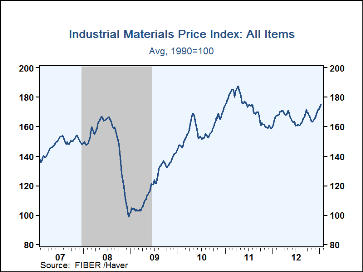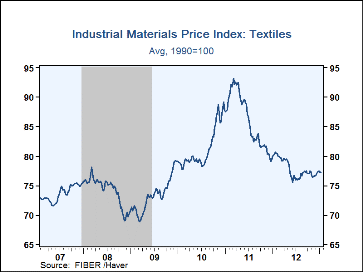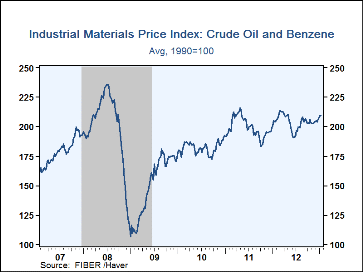 Global| Jan 14 2013
Global| Jan 14 2013FIBER: Commodity Prices Are Showing More Life
by:Tom Moeller
|in:Economy in Brief
Summary
There's been nothing stealth about recent movements in commodity prices. Many have jumped while others have held firm. That combination has raised the latest commodity price index from the International Business and Economic Research [...]
There's been nothing stealth about recent movements in commodity prices. Many have jumped while others have held firm. That combination has raised the latest commodity price index from the International Business and Economic Research (FIBER) to its highest level since June 2011. At 175.1, last Friday's reading was up 7.3% from 12 months earlier and by roughly the same amount since early November. That suggests that recent weakness in factory sector output will prove short-lived. During the last ten years there has been a 44% correlation between the three-month change in prices and the change in factory sector industrial production.
 As factory output weakened with the effects of Hurricane Sandy,
commodity prices fell. That likely helped reduce growth in Q4 real GDP to
roughly one percent, according to economists' estimates. Now there's
evidence of a turnaround. Still leading the
improvement are prices in the miscellaneous group. The gain reflects
surging prices for framing lumber (42.5% y/y) and structural panels (49.1%
y/y). In the metals group, earlier declines have stabilized. Prices
for lead (14.2% y/y) and copper scrap (2.1% y/y) have been notably strong.
Aluminum (-3.8% y/y) and steel scrap (-13.0% y/y) prices have stabilized
but remain down versus last year. In the textile group, prices have
rebounded following the storm led by a recovery in cotton prices but they
remain down 20.4% y/y. Crude oil prices (-5.9% y/y) showed a
delayed recovery but have risen nearly 10% since the early-December low.
As factory output weakened with the effects of Hurricane Sandy,
commodity prices fell. That likely helped reduce growth in Q4 real GDP to
roughly one percent, according to economists' estimates. Now there's
evidence of a turnaround. Still leading the
improvement are prices in the miscellaneous group. The gain reflects
surging prices for framing lumber (42.5% y/y) and structural panels (49.1%
y/y). In the metals group, earlier declines have stabilized. Prices
for lead (14.2% y/y) and copper scrap (2.1% y/y) have been notably strong.
Aluminum (-3.8% y/y) and steel scrap (-13.0% y/y) prices have stabilized
but remain down versus last year. In the textile group, prices have
rebounded following the storm led by a recovery in cotton prices but they
remain down 20.4% y/y. Crude oil prices (-5.9% y/y) showed a
delayed recovery but have risen nearly 10% since the early-December low.
The current forecast for industrial output from the National Association for Business Economics calls for 2.6% growth this year. That follows a 3.7% increase last year and is the weakest gain of the economic recovery. As such, the rate of improvement in industrial commodity prices should ease as 2013 progresses but the direction of change will be upward.
Commodity price data can be found in Haver's DAILY, WEEKLY, USECON and CMDTY databases.
| FIBER Industrial Materials Price Index (1990=100) | 01/11/13 | Y/Y % | 2012 | 2011 | 2010 |
|---|---|---|---|---|---|
| All Items | 175.1 | 7.3 | 166.4 | 173.0 | 157.9 |
| Textiles | 77.3 | -3.5 | 77.9 | 86.1 | 81.3 |
| Cotton (cents per pound) | 70.9 | -20.4 | 74.5 | 132.8 | 87.8 |
| Metals | 255.1 | 2.7 | 243.0 | 278.7 | 240.0 |
| Aluminum ($ per metric ton) | 2,074.0 | -3.8 | 2,019.6 | 2,400.9 | 2,172.1 |
| Copper Scrap (cents per pound) | 368.1 | 2.1 | 360.6 | 400.3 | 326.8 |
| Steel Scrap ($ per ton) | 349.3 | -13.0 | 366.7 | 412.6 | 326.5 |
| Crude Oil & Benzene | 206.7 | 1.4 | 204.1 | 199.3 | 182.0 |
| Crude Oil (WTI, $ per Barrel) | 93.2 | -5.9 | 94.2 | 95.0 | 79.4 |
| Miscellaneous | 230.9 | 25.3 | 205.3 | 190.6 | 179.1 |
| Framing Lumber ($ per 1000 board ft.) | 389 | 42.5 | 321 | 273 | 283 |
| Natural Rubber (cents per pound) | 215.5 | 4s.3 | 211.9 | 262.3 | 182.9 |
Tom Moeller
AuthorMore in Author Profile »Prior to joining Haver Analytics in 2000, Mr. Moeller worked as the Economist at Chancellor Capital Management from 1985 to 1999. There, he developed comprehensive economic forecasts and interpreted economic data for equity and fixed income portfolio managers. Also at Chancellor, Mr. Moeller worked as an equity analyst and was responsible for researching and rating companies in the economically sensitive automobile and housing industries for investment in Chancellor’s equity portfolio. Prior to joining Chancellor, Mr. Moeller was an Economist at Citibank from 1979 to 1984. He also analyzed pricing behavior in the metals industry for the Council on Wage and Price Stability in Washington, D.C. In 1999, Mr. Moeller received the award for most accurate forecast from the Forecasters' Club of New York. From 1990 to 1992 he was President of the New York Association for Business Economists. Mr. Moeller earned an M.B.A. in Finance from Fordham University, where he graduated in 1987. He holds a Bachelor of Arts in Economics from George Washington University.










